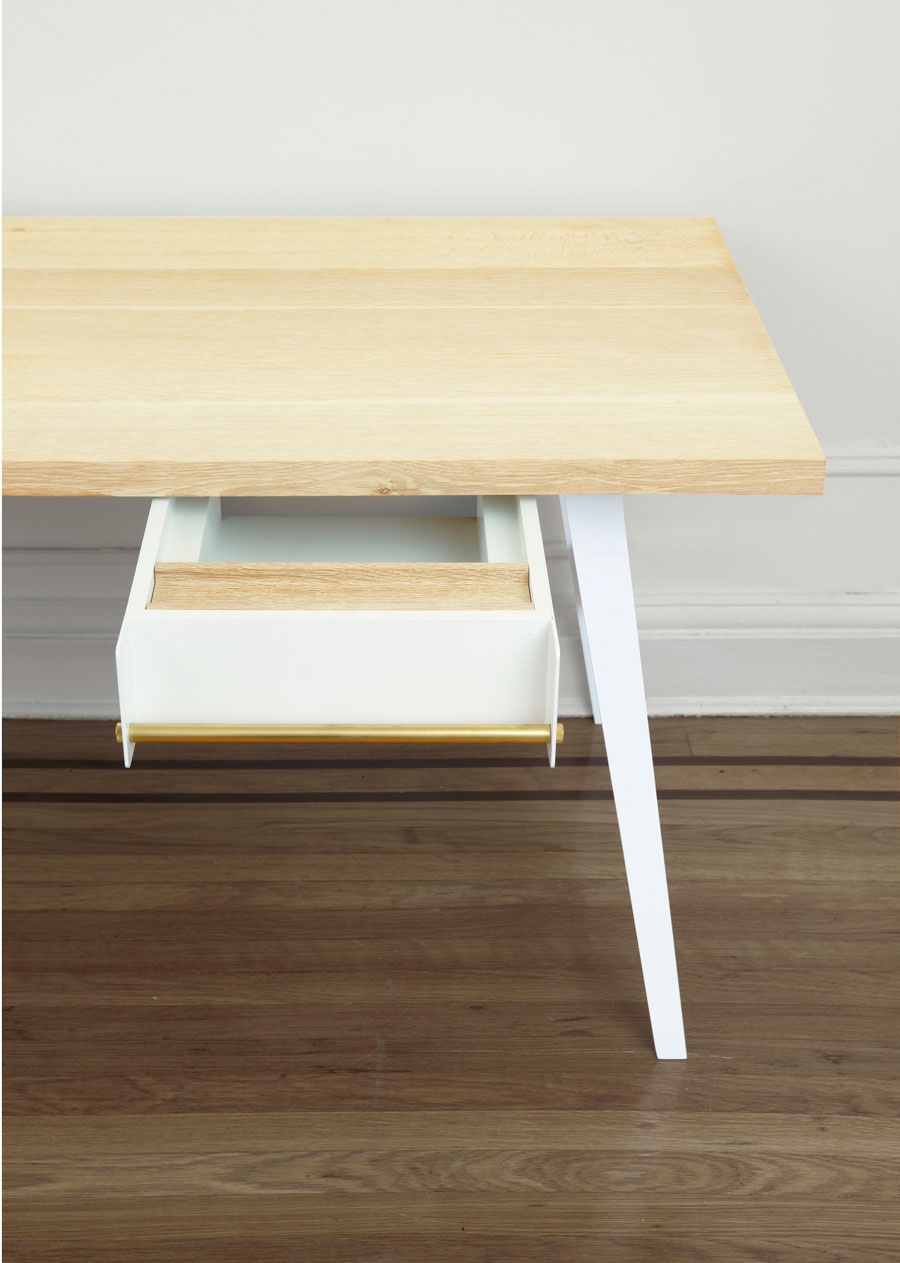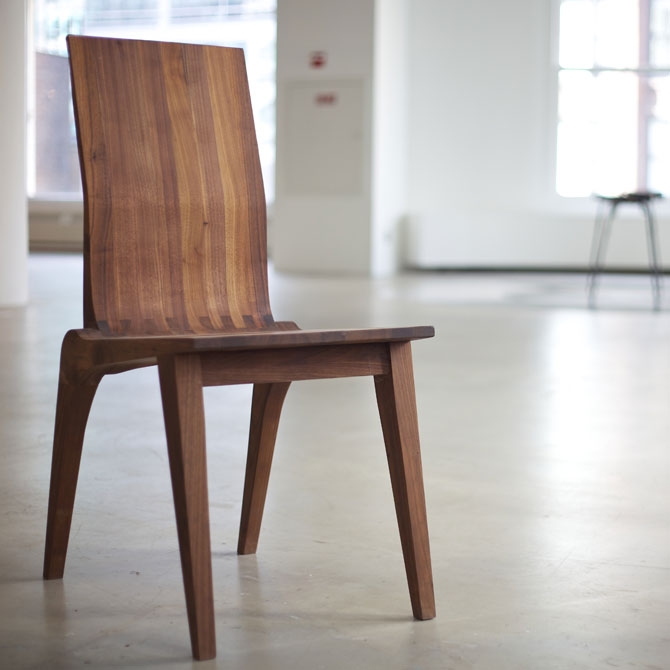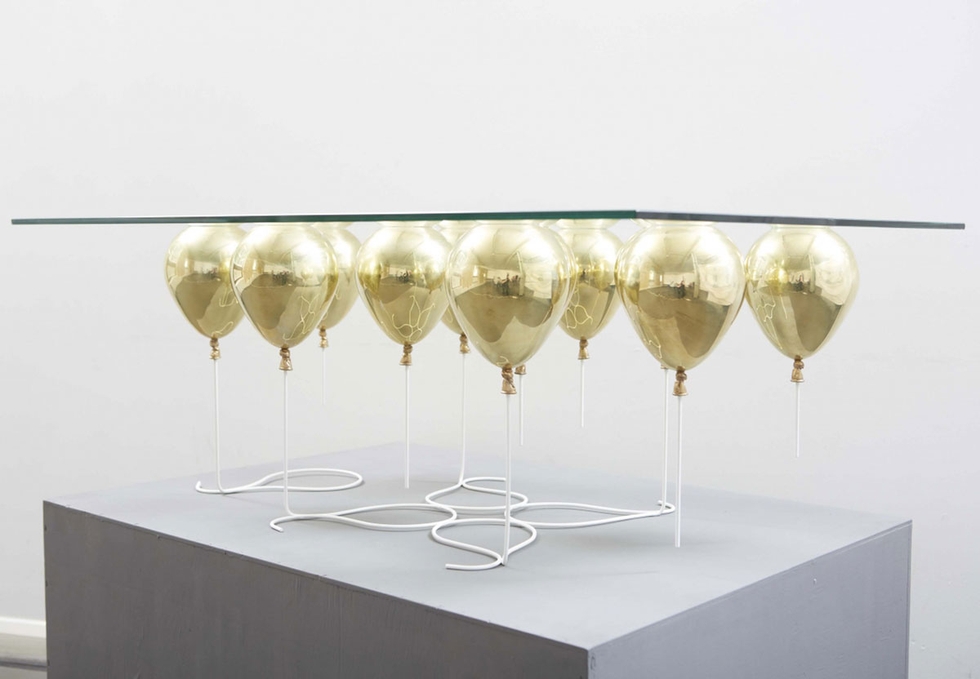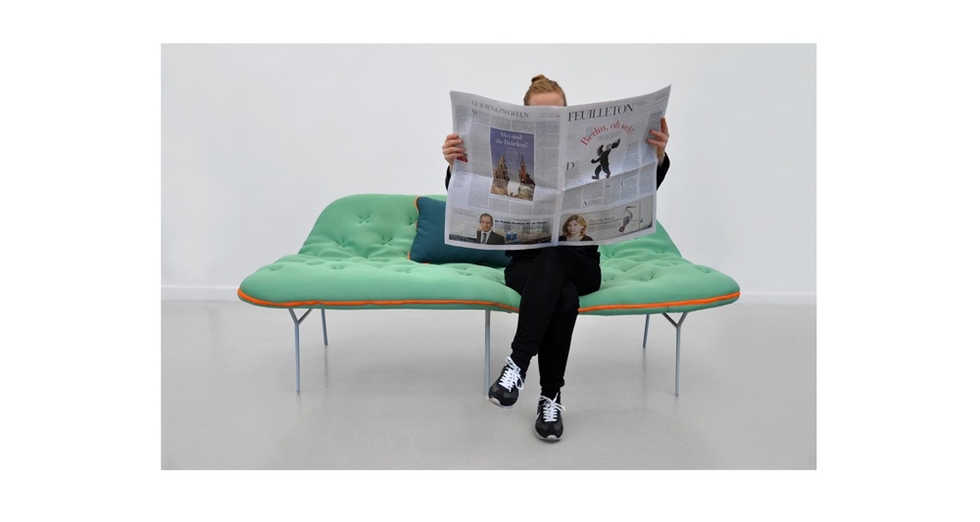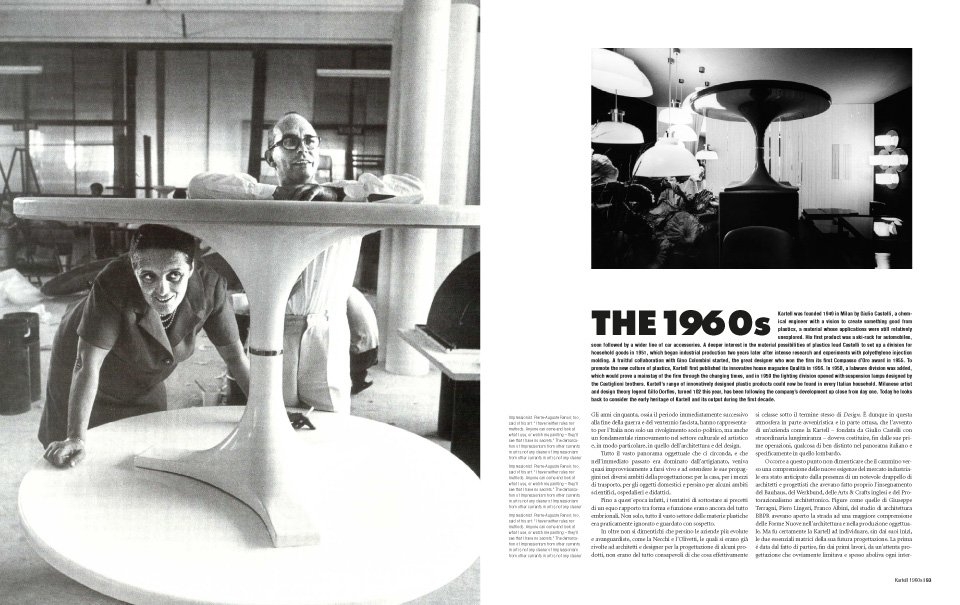The Strik chair combines clean, curved lines and an efficient, functional design that reduces clutter in the home. Kristina Jaer designed the Strik chair with a frame made from ash tree wood, a reversible wool blanket, and the concept that a chair should be able to "invite closeness." While the traditional wool blanket might seem like an obvious addition to the bare wood frame of the chair, the shape of the blanket actually provides the chair with a distinctive shape. And the chair offers the blanket a fitting place to rest.
New York-based architecture and design practice Produce Design Studio recently relaunched. Its first new product, the Claus Desk, was just unveiled this week. Rethinking the contemporary work desk is a worthy endeavor, and Produce has done well. The Claus has a lightness to it, a refined style that should work in various contexts plus it makes the most of the natural beauty of its prime material, white oak, and the sturdiness of its powder-coated metal legs.
The Claus Desk is available through produce-design.com.
Early last year, Unbranded Designs co-founder Sameer Dohadwala thought it would be easy to build his own custom desk. After a process he jokes was a miserable failure—all that was left were Home Depot receipts and a “pile of wood and broken dreams”—he sought out independent designers to help finish the job. That's when he had an epiphany. With co-founders Samer Saab and Max Greenblatt, he could create a better way to bring well-designed furniture to the masses.
That spark led to Unbranded Designs, a new online design community and furniture manufacturing concern in Chicago. Dohadwala met with independent designers and found that most had amazing prototypes and renderings in their studios, unrealized and unseen by the masses. “Their work was much more interesting than the mass-designed pieces we had been looking at,” said Dohadwala. “I wanted all of them in my apartment.”

These designs didn’t reach fruition, the Unbranded team learned, because designers lacked a combination of seed money, manufacturing know-how, and marketing and sales savvy to begin production. This inspired the trio’s concept, a kind of Threadless for furniture, which aims to provide technical and logistical support and a ready network of local and regional artisans and manufacturers. Users submit designs, such as Philip Royster’s R2 table (pictured above) which boasts a unique curved pattern built with fishing wire. Comments and feedback are exchanged and the more popular, unique pieces get built in small custom runs and sold by Unbranded. The catalog boasts over a dozen pieces, constantly cycled in and out; currently, the site’s offering the angled ISA chair by School of the Art Institute grad student Adele Cuartelon, built by DKE Design.
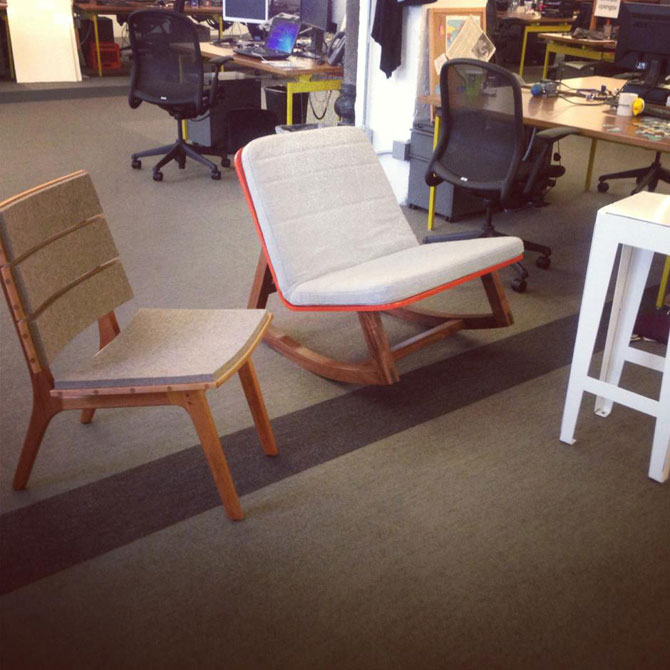
Business interest has been growing—Unbranded won the Chicago Lean Startup Challenge last fall and is finishing a new round of seed funding—and the startup now runs out of 1871, a tech space inside Chicago’s Merchandise Mart, itself an iconic building and a center of furniture and design. It’s a fitting home for a new type of manufacturing and design. “I think it’s as practical as it is symbolic,” says Dohadwala. “We’re at a place where we’re trying to disrupt the industry with technology.”
Have a design in mind? Bring it to unbrandeddesigns.com
We’re not good at keeping secrets, and in the case of Jason Koharik, who collects and fabricates objects in his Echo Park garage under the moniker COLLECTEDby, we can’t keep quiet.
Koharik designed a weirdly elegant, Mouille-esque line of lighting that’s been making appearances around LA recently. His furniture collection, however, came as a bit of a surprise. Koharik has long been accumulating vintage furniture (mostly chairs) from the likes of Eileen Gray, Tobia Scarpa and Bruno Mathsson. Over time, he amassed a singular collection. Rather than leaving the pieces in their original, mostly unusable condition, Koharik meticulously retooled each object, leaving the essential structure and design unaffected, but contributing his own sleek, hewn-by-hand signature to the upholstery and finish.
The resulting collection is a warm, textured exploration of the merging of leather and line, metal, wood and otherwise, all observed from a reverent by reimagined viewpoint. His collection, which also includes new luminaires, handmade furniture, and original artwork, debuted at a public sale in November, 2012. Red dots came quickly.
Hopefully, the warm reception will carry his works beyond the confines of a draft warehouse on Glendale Blvd and into the foreground of contemporary design.
Visit collectedby.com to see Jason Koharik's latest work.
The decadent UP coffee table, recently released by design studio Duffy London, is a glass panel supported by a group of small metal balloons. If you can get past that there's something slightly Entertainment 720 about it, the goofy elegance and implied weightlessness would make any living room a little more buoyant. Christopher Duffy (who also designed the swing chair) is limiting this run to twenty. Details on how many he has left are up in the air.
Anyone who has ever spent a cold night on a friend's sofa has probably thought a few design changes might have made the overnight more comfortable. Industrial designer Stephanie Hornig has done a public service for couch-surfers everywhere by making a few simple modifications to the daybed that make crashing on the couch a little bit less of a bummer.
This modified daybed, which is part of her new Camp line of furniture, has two major modifications. First, she eliminated the moving parts inherent in futons and pull-out couches and gave her daybed a shape that's suitable for sitting and a width that's suitable for sleeping. Second, she sliced the daybed mattress in half and added a zipper to give the bed a built-in blanket, not unlike a sleeping bag. The clear separation between the couch and the bed will definitely keep germaphobes happy, and the bright fabrics add some punch.
See the entire Camp line at stephaniehornig.com.
Plastic is hardly en vogue these days with young designers. But that doesn't mean that the petroleum byproduct is going away. For decades, remember, plastic was the stuff of brilliant, forward-thinking design. You might call those decades the Kartell era.
Carbon polymers were never in better hands than with the Italian company Kartell. Founded in 1949 by a chemical engineer, the company's collaboration with designer Gino Colombini ushered in an era of award-winning and useful designs. The golden age of plastic had Anna Castelli Ferrieri and Joe Colombo designing for Kartell. More recently, the Starck Ghost Chair has revived that high level of chic utility that's the hallmark of Kartell. Taschen's latest book surveys the company's history decade-by-decade with an eye-popping array of historical shots.
Last month the IMM held its annual furniture trade show in Cologne, and showcased over 1,250 designers to over 142,000 visitors.
The new Slagbaenk from BFex might be our favorite find of IMM. It's a modular take on the typical kitchen bench essential to every Scandinavian home. There are three essential functions to the slagbaenk: it has to provide proper seating for a meal at the kitchen table, have a storage compartment, and provide more relaxed, daybed-style seating. Bfex used five planks of wood and two chairs to create a new minimal take on the bench that definitely fits within their mantra: "Art with function – Design without."
The Daniel Becker Design Studio caught our eye with its more functional take on the fireplace tile. It named the line after the chilly German capital, Berlin. The tiles were designed to have a three-dimensional form, which increases the surface area of each piece and, therefore, how much heat the tiles can release. No design integrity was sacrificed for the energy efficiency of the series either. The tiles come in four sizes and have a simple concentric pattern that allows interior designers to configure them as they wish.
It's hard to improve upon the simplicity of a wood bookshelf, but industrial design student Lucien Gumy managed to refine the shelf in a subtle way. He designed a new shelving system, titled simply, "l'étagère en bois" or "wooden shelf," that uses special joints instead of screws or nails to make the shelf customizable and easy to assemble. The system won him the D3 Student award, a well-deserved honor at IMM.
New York City-based Ana Kras uses leftover cotton threads to build unpretentious yet complex lampshades that are as beautiful as they are practical. The Serbian designer makes each lantern by hand, focusing on unique shapes and abstract patterns. With her first collection in the works, we spoke with the multi-talented artist about her gorgeously earthy, one-of-a-kind shades.
You describe your Bonbon lamps as a family of lanterns. When and how was the original Bonbon lamp first conceived?
The first Bonbon was made in my apartment in Belgrade in fall of 2009. I was working on another lamp and had an extra lampshade frame sitting on my kitchen floor for weeks. I think that object was in the corner of my eye for too long, so I subconsciously thought of how to make something out of it. I got the idea of wrapping cotton threads around in a certain way and tried it and that's how the first Bonbon lamp was made.
How long does it take to construct each lamp?
First, I have frames built by a metal manufacturer and then powder-coated or plated and then it's time for my handwork. It takes about twenty hours of patient work to make the smallest one, and much more for bigger ones.
From where do you source your cotton thread?
So far, I have been using the leftovers from a Serbian knitwear company called Ivko Knits. They were so kind to support me at the very beginning. In fashion industry, things change very fast; each season brings new color palettes and the old threads are stored or thrown away. It's a nice gesture to recycle things. If, by any chance, someone who works with knitwear reads this and wants to collaborate, please let me know!
How has the Bonbon evolved since its initial creation?
Each new Bonbon is different from the previous one. I am always trying new shapes and new patterns. Lately, I have been into abstract patterns. I am also developing many new shapes and some more complex pieces consisting of multiple parts. So far, I have been making Bonbon’s usually per request, but I’m working on making a first collection, with small editions of each lamp.
* Prices are based on size and start at $1300.
The Bonbon lamp is available at anakras.com
Designophiles tend to associate Vitsœ with the 606 shelving system by Dieter Rams—a modern classic. The company's mission, to help us 'live better with less that lasts longer" is more relevant than ever. But there's much more to the story than the iconic furniture by Rams. Vitsœ has put Tumblr to good use in releasing bits and bobs, photos, graphics, and projects from its incredible archive. There's everything from a company holiday card to a Neville Brody (of The Face fame) design for the 606 launch in the UK, plus lots of photos of Rams doing his thing. My current fave is the post on the record pressed in the '70s for a band performing at the furniture showroom in Karlsruhe, Germany. One small request: post more often, please.

